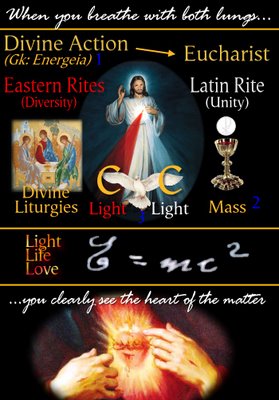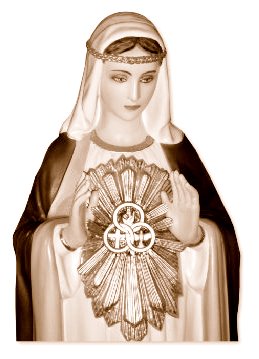J.M.J. + O.B.T. + M.G.R.*
From the source at:
http://www.revjim.ca/sermons/20130331srm.pdf
“First Light”– John 20:1-18–Easter
Sunday
Easter Sunday! Day of days in the
Christian church; focal point of the Christian year. Once again we gather to
celebrate, to listen to the resurrection story. One might think that this story
would get a bit ‘old’, a bit ‘stale’ hearing it over and over again. But it
doesn’t, at least not for me. This is the most exciting story in scripture, and
each year there seems to be a different emphasis, a different understanding.
Not substantially different, because the foundation of the story remains the
same, indeed we usually read the same version of the story every year. But there
always seems a particular emphasis that surges forth in any given year, and
this year for me the emphasis is about Christ being among the living.
Not that all Christians share this
emphasis, and certainly the secular world and media are happy enough to ignore
it. For example, in the past few days the authenticity of the Shroud of Turin
has been shoved into the public eye by the publication of another book on the
subject. The book attempts to refute some careful scientific analysis that was
done a couple of years ago, analysis that came to the conclusion that the
shroud was a fake created in the Middle Ages. The recent book argues that what
the scientists tested was fabric that had been used to repair the shroud in the
Middle Ages, but that the shroud itself is really the burial cloth in which
Jesus was wrapped before being laid in the tomb.
Does it matter if the Shroud of
Turin is real or not? Not really, because the real cause for celebration is the
resurrection–that Jesus rose as the Christ triumphant over death. For those of us
in the Reformed tradition the resurrection triumphs even the crucifixion–that’s
why in Protestant churches we do not have crucifixes, but instead empty
crosses.
[The two paragraphs above reveal some negative Protestant attitudes toward Catholicism which I do not share. It's a sad commentary that they color this otherwise instructive piece.]
Scripture, and this reading from
John’s gospel especially, clearly moves us beyond that suffering; puts the
passion of Jesus into perspective; shifts the focus from death to living. The very way the events unfold in
this divine story move us in that direction. John scripts here a two-act play
directed by God that reveals the magnificent meaning of that moment. The first
act is about death, darkness, and despair; the second act is about shining
light, and the glow of God’s grace illuminating Mary, the disciples, and the
whole earth. We are propelled along with Mary Magdalene from darkness into
light, from despair into bewildered joy; from solitude into discipleship and
communion.
Let’s take another look–the story
goes by so quickly when we read it. The story opens in darkness, and quiet.
“Early on the first day of the week, when it was still dark”, the text begins.
Darkness, cloaking the furtive movements of Mary Magdalene, slipping through
the streets to go to the tomb where the bruised, beaten and battered body of
Jesus had been placed. She moves cautiously from deep
shadow to deep shadow, knowing that she is at risk from the patrolling soldiers
because of her known association with this criminal who had been executed. The very fact that she is taking
this risk helps us to feel her despair: there was no good reason for her to go
to the tomb, she would not be able to lift, roll or slide away the cover by
herself, so she can only be going there to be as near as she could be to this
man who had so completely changed her life.
[Darkness, for sure, but despair? Might Mary Magdalene be filled with expectant hope that compels her to act so heroically?]
And the darkness deepens. In the
same way that the night darkens just before the dawn, the darkness of her
despair deepens also, as she discovers that the tomb has been opened, and it lies
empty. Running to gather Peter and the disciple whom Jesus loved, she cries to
them that the body of the Lord had been taken out of the tomb, and is now
missing. Sharing her grief and confusion, these two disciples race to the tomb,
discovering that she was telling the truth, and return back home in confusion,
not yet understanding the meaning of it all. So deep is the darkness of their
despair and confusion that not even their faith is enough to illuminate the fulfillment
of scripture happening right before their eyes–they fail to grasp the meaning
of the first big clue that this is not merely a further desecration of his
body. They fail to note that the head wrappings had been carefully rolled up
and set aside. The confused and saddened disciples return home, leaving Mary
alone in her darkness as the first scene comes to a somber close.
The curtain reopens on the second
scene with Mary still alone in her darkness, weeping outside the tomb. But her
first action of looking into the tomb provides the first ray of heavenly light
to shine through as she sees two angels in white, who ask her, “woman, why are
you crying?” She answers them through her tears. Again the question is asked of
her, but this time by Jesus, standing there. The earth is now bathed in the
light of the world, but still Mary cannot see that it is Jesus. Finally, he
calls her name, and recognition and understanding flood in like the burst of
daylight as the sun clears the horizon and dispels the darkness. “Mary!”, he
calls to her, and she responds by calling him “Rabbouni!” That is the dramatic moment
when the full impact of what was happening lights up for Mary Magdalene like a
movie set under arc lamps; this is the moment that she understands that what
Jesus had foretold them had indeed come true, that on the third day God would
raise him up again. New light floods the corners of the darkness of despair,
with God’s grace shining like the fresh, clean light of a new day. New hope, with the recognition of a
whole new way of relating to and with God. New life, as promised by the one now
risen again, the one who declared “I have come that you might have life, and
life abundantly.” The shift is complete, the darkness dispelled, the new light
and life given by God in Christ.
But there’s a third scene also, a
scene that hasn’t yet finished. “Do not hold on to me, for I have not yet
ascended to the Father. Go to my brothers and tell them, “I am ascending to my Father
and your Father, to my God and your God.” This third scene opens with Jesus’
promise of ascension into heaven, and with that promise is tied all his other
promises: new life; the gift of the Holy Spirit; assurance of his presence and
of reconciliation and forgiveness. The focus is now clearly shifted away from
grieving, and into celebration of the living Christ.
This is a wondrous drama that we
could watch a hundred times or more, and be moved by it each and every time.
But it is not a story merely to be heard, a play simply to be watched and enjoyed. This is a story about Christ among
the living, and we are to live this story. We die with Christ in our baptism,
the apostle Paul tells us, and we live as one with Christ in his body, the church. By the waters of baptism and the
power of the Holy Spirit God claims us and calls each one by name. God unites
us to Christ in his death and resurrection and also grafts us into the body of
Christ as members of the church. This story is about Christ living
among the living, and this resurrection story calls us to remember how we came into
that new life.
We are–in our turn-the living among
whom Christ lives. Live this story. As you watch the resurrection story move from
darkness into light, remember the times you were sunk in your own despair,
feeling cut off from all that was important to you, and remember also how encountering
the risen Christ has brought you back into light, and life. I’m sure we can
recall the many times we were confused, adrift and questioning, seeking to find
faith even as Christ stood right beside us. Blessed are you if you can identify
and remember that moment when you heard Christ call you by name, and so much
came clear, and God’s grace flooded into your life. Blessed are we all as we realize the
wondrous gift of new life in Christ, freely offered to us.
And just as this magnificent and
divine story didn’t end there at the tomb, but went on with Mary being
instructed to “go, tell the others”, the story continues also for us as we live
it. We, like Mary, are also commanded to
“go, tell the others”, to proclaim to them by our very lives the joy that we
have found in encountering the risen Christ. Like Mary Magdalene, and the other
disciples, we won’t always be running with breathless excitement–there will be
times when it seems like hard slogging, just as it was for them as they
continued to spread the message of God’s redeeming love sealed in the new covenant
of Christ’s blood to the whole world. Some days we find it grueling to do that
just in our little corner of the kingdom. But the message is about living, and
living in and with the risen Christ, and it is his presence with us, supporting
and uplifting us with his Holy Spirit, that gives us not just the strength but
also the joy to continue going and telling the others.
On this glorious Easter Sunday
morning, hear once again the marvelous story of the resurrection, the rising
again from death of Jesus as the Christ, and be reminded yet again that this is
the story of God’s grace, God’s forgiveness. This is not a story of revenge, of
punishment, of death This is a story about life and living This is a marvelous
affirmation of redemption, of new and abundant and rich and joyous life shared
with Christ who lives among us. This is a story of the grace of the one God, Father,
Son and Holy Spirit to whom we give all thanks and honour and praise.
+ + +
Upon further review, a deeper Truth has come to light: Mary Magdalene was given a glimpse of the Ark of the Covenant. That might explain why the Blessed Mother was 'absent' from this living encounter with Jesus Christ, the Gardener near the Mercy Seat in the Holy Sepulchre.
Rembrandt got it!
.
Sincerely yours in Jesus through Mary,
Mike Rizzio
Imitate Mary
Become like Jesus
Live for the Triune God
Seek the Light of Our Lord Jesus Christ
See you on the High Ground!
* - J.M.J. + O.B.T. + M.G.R. stands for:
Jesus, Mary and Joseph;
O Beata Trinitas;
St. Michael, St. Gabriel and St. Raphael





























No comments:
Post a Comment